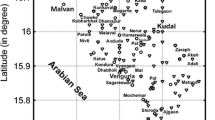Abstract
Aquifer porosity indicates the storage groundwater capacity and groundwater quality. It may be measured via different techniques. This paper presents a novel spatial methodology based on radial basis function (RBF) and neuro-fuzzy inference system for modelling the porosity. Use of the point cumulative semimadogram in RBF as a spatial measure is a novel contribution. In addition, the methodology examines the use of a neural network-based fuzzy inference system for porosity estimation. Performance comparisons with conventional methods show that the proposed spatial model has high modelling and generalization capability.









Similar content being viewed by others
Explore related subjects
Discover the latest articles and news from researchers in related subjects, suggested using machine learning.References
Tutmez B, Hatipoglu Z (2007) Spatial estimation model of porosity. Comput Geosci 33:465–475
Taud H, Martinez-Angeles R, Parrot JF, Hemandez-Escobedo L (2005) Porosity estimation method by X-ray computed tomography. J Petrol Sci Eng 47:209–217
Clausnitzer V, Hopmans JW (1999) Determination of phase-volume fractions from tomographic measurements in two-phase systems. Adv Water Resour 22(6):577–584
Bardossy GY, Fodor J (2004) Evaluation of uncertainties and risks in geology. Springer, Heidelberg
Demicco RV, Klir GJ (2004) Fuzzy logic in geology. Elsevier, Amsterdam
Jang JSR, Sun CT, Mizutani E (1997) Neuro-fuzzy and soft computing. Prentice-Hall, London
Dixon B (2005) Applicability of neuro-fuzzy techniques in predicting ground-water vulnerability: a GIS-based sensitivity analysis. J Hydrol 309(1–4):17–38
Tutmez B, Hatipoglu Z, Kaymak U (2006) Modelling electrical conductivity of groundwater using an adaptive neuro-fuzzy inference system. Comput Geosci 32:421–433
Powel MJD (1987) Radial basis functions for multivariable interpolation: a review. In: Mason JC, Cox MG (eds) Algorithms for approximation. Oxford University Press, New-York
Broomhead DS, Lowe D (1988) Multivariable functional interpolation and adaptive networks. Complex Syst 2:321–355
Lin GF, Chen LH (2004) A spatial interpolation method based on radial basis function networks incorporating a semivariogram model. J Hydrol 288:288–298
Deutsch CV, Journel AG (1998) Geostatistical software library (GSLIB) and user’s guide. Oxford University Press, New-York
Tutmez B, Tercan AE, Kaymak U (2007) Fuzzy modelling for reserve estimation based on spatial variability. Math Geol 39(1):86–111
Leski J, Czogala E (1999) A new artificial neural network based fuzzy inference systems with moving consequents in if-then rules and its applications. Fuzzy Sets Syst 108:289–297
Czogala E, Leski J (2000) Fuzzy and neuro-fuzzy intelligent systems. Physica-Verlag, Heidelberg
Xie XL, Beni GA (1991) A validity measure for fuzzy clustering. IEEE Trans Pattern Anal Mach Intell 13(8):841–847
Luger GF, Stubblefield WA (1998) Artificial intelligence: structure and strategies for complex problem solving. Addison Vesley Longman, London
Leski J, Czogala E (1997) A new artificial neural network based fuzzy inference systems with moving consequents in if-then rules. BUSEFAL 71:72–81
Piegat A (2001) Fuzzy modeling and control. Physica-Verlag, New York
Hatipoglu Z (2004) Hydrogeochemistry of Mersin-Tarsus coastal aquifer, Ph.D Thesis, Hacettepe University, Ankara
Bezdek JC, Ehrlich R, Full W (1984) FCM: the fuzzy c-means clustering algorithm. Comput Geosci 10(2–3):191–203
Webster R, Oliver MA (2001) Geostatistics for environmental scientists. Wiley, Chichester
Author information
Authors and Affiliations
Corresponding author
Rights and permissions
About this article
Cite this article
Tutmez, B. Assessment of porosity using spatial correlation-based radial basis function and neuro-fuzzy inference system. Neural Comput & Applic 19, 499–505 (2010). https://doi.org/10.1007/s00521-009-0326-3
Received:
Accepted:
Published:
Issue Date:
DOI: https://doi.org/10.1007/s00521-009-0326-3




